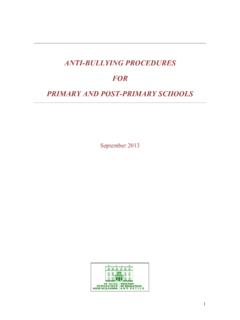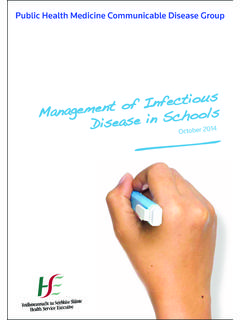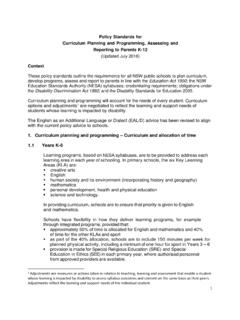Transcription of Biology Support Materials - Laboratory Handbook for ...
1 Biology . Leaving Certificate Ordinary Level and Higher Level Support Materials . Laboratory Handbook for Teachers Biology . Leaving Certificate Ordinary Level and Higher Level Support Materials . Laboratory Handbook for Teachers The NCCA acknowledges the assistance of the National Biology Support Service in the production of this material . Biology . CONTENTS. 1 SECTION ONE: INTRODUCTION 1. SECTION TWO: GUIDELINES FOR THE. 2 STUDENT NOTEBOOK OR FOLDER 7. 3 SECTION THREE: PRESCRIBED ACTIVITIES 11. 4 S E C T I O N F O U R : M AT E R I A L S A N D E Q U I P M E N T 107. Biology . Biology . Section One Introduction 1. Introduction 2. 2. Syllabus aims 2. 3. Syllabus objective 2. 4. Practical activities 2. 5. Rationale for practical activities 3. 6. Student practical activity 3. 7. Skill attainment 4. 8. Laboratory organisation and maintenance 4.
2 9. Safety 5. 10. Assessment 5. 11. References 5. 1. Biology . 1. INTRODUCTION. This Handbook offers guidance for teachers on the central issues of the prescribed practical activities in the Leaving Certificate Biology syllabus. The main focus of these activities for students is the attainment of practical skills. The emphasis is on the process rather than on product attainment alone. The intention is, that by focusing on a high level of practical skills, students will be better prepared for further education, training and employment in science related areas. The syllabus prescribes twenty two practical activities for students. When arranging practical activities for students with special educational needs, including students with severe learning difficulties, it is important to break down the activities into small steps.
3 You may also need advice and guidance on how apparatus and other facilities in the Laboratory can be modified to provide maximum opportunity and safety for the students. In all practical work, teachers are required to develop a positive attitude towards safety and instruct their students in the appropriate safety procedures. 2. SYLLABUS AIMS. The aims of the syllabus are to: Contribute to students' general education through their involvement in the process of scientific investigation Encourage in students an attitude of scientific enquiry, of curiosity and self-discovery through (i) individual study and personal initiative (ii) team work (iii) class-directed work 3. SYLLABUS OBJECTIVE. The syllabus includes the following objective: To impart a knowledge and understanding of biological experimental techniques, including practical Laboratory skills 4.
4 PRACTICAL ACTIVITIES. The primary emphasis of practical activities is skill attainment. In the course of their studies of the syllabus, students will follow a course of practical work, Laboratory work and fieldwork that includes 22 prescribed activities. 2. Biology . 5. RATIONALE FOR PRACTICAL ACTIVITIES. Natural science is the study and accumulation of knowledge about material things and events in the universe. Organisms form part of these "things" and "events". Biology , the study of life, is one of the disciplines within the natural sciences. The method of scientific study falls within the framework described as the scientific method: making observations, formulating a hypothesis, designing a controlled experiment, collecting and interpreting data, reaching conclusions, placement of conclusions in the context of existing knowledge, reporting and publishing results, development of theory and principle.
5 There should be an appreciation of the errors possible in activities and of the precautions or controls that can be applied to reduce such errors. Students should be aware that in their study of Biology the value of the scientific method is limited by (a) the extent of our basic knowledge, (b) the basis of investigation, (c) our ability to interpret results, (d) its application to the natural world that is always subject to change and (e) accidental discoveries. As the study of Biology is incomplete without the study and application of the scientific method, practical activity forms an essential and mandatory part of this course. Students should be encouraged to integrate information and communication technologies (ICTs). into their study of Biology . 6. STUDENT PRACTICAL ACTIVITY. Practical activity for students: Introduces them to a scientific method of investigation Allows for greater development of affective and psychomotor forms of learning Encourages accurate observation and careful recording Promotes simple, commonsense scientific methods of thought Develops manipulative skills Gives training in problem solving Elucidates the theoretical work so as to aid comprehension Verifies facts and principles already taught Arouses and maintains interest in Biology Makes biological, chemical, and physical phenomena more real through actual experience 3.
6 Biology . 7. SKILL ATTAINMENT. The skills developed primarily through the practical activities include: Manipulation of apparatus Following instructions Observation Recording Interpretation of observations and results Practical enquiry and application of results Manipulation of apparatus involves manual dexterity and efficiency using appropriate methods in collecting required specimens in an ecological study; being familiar with and using the light microscope to prepare and examine a plant cell; dissecting an ox's or a sheep's heart; conducting a series of Laboratory activities and investigations safely and humanely. Following instructions involves adherence to the instructed or recorded sequence of actions required to carry out an activity ability to follow instructions from a practical manual. Observation is the most important tenet of the scientific method.
7 All knowledge of Biology is based on situations in which a biologist observes a particular event and records it. Instruments are used to extend our perceptual limits. Appropriateness, accuracy and completeness of observation need to be practised, monitored and guided from relevant theoretical criteria for their acquisition. These qualities will be identified from the student's notebook. Recording is another essential tenet of the scientific method. Records are proof of what has been completed in the activity and what can be repeated with similar expected outcomes. Guidelines on the recording of practical activities are highlighted in Section three. Interpretation of observations and results should ensue from the hypothesis being tested or the investigation undertaken. The final interpretation should be coherent and should explain clearly how conclusions are reached.
8 Practical enquiry and application of results if results are ambiguous, the student should be required to consider the results, and where necessary to repeat the activity or to design a new activity. The student may consider the results in a wider context and make suggestions or identify the activity as a scientific paradigm (an activity that serves as a model for further work). 8. Laboratory ORGANISATION AND MAINTENANCE. The syllabus requires that students have access to a Laboratory with supervision. The Laboratory should be designed to enable the activities required by the syllabus and any other practical work to be carried out in a safe manner. The teacher should review the equipment and Laboratory facilities available and then, in conjunction with the syllabus and the teacher guidelines, organise the students' activities, teacher demonstrations and any other activities.
9 It is important to maintain the Laboratory equipment by ensuring that repairs are carried out as needed and that equipment is stored safely when not in use. It is also important to remind students that the final stage of Laboratory work is cleaning up return all Materials and solutions, clean up the work-bench and dispose of any waste Materials carefully and efficiently, as directed by the teacher . 4. Biology . 9. SAFETY. In all practical work safety must be a major concern. Teachers are encouraged to develop in their students positive attitudes and approaches to safety in the range of activities they encounter and to inculcate in them an awareness of the value of creating a safe working environment. Standard Laboratory safety precautions should be observed and care taken when carrying out all activities. All legal and health regulations must be adhered to in activities involving live and dead organisms.
10 Before rearing and maintaining organisms, detailed information on the appropriate methods for the rearing and maintenance of the organisms must be studied. These methods must be strictly adhered to during the activity. The general principles of safe Laboratory working procedures apply to Leaving Certificate Biology . The Department of Education and Science has published two booklets Safety in School Science (1996) and Safety in the School Laboratory - disposal of chemicals (1996). Specific reference to biological safety is highlighted under "Biological Hazards". Teachers should draw up a list of Laboratory rules. This list should be posted in a prominent place in the Laboratory and students' attention should be drawn to it on a regular basis. Before starting a practical activity students should be made aware of the relevant safety considerations.










